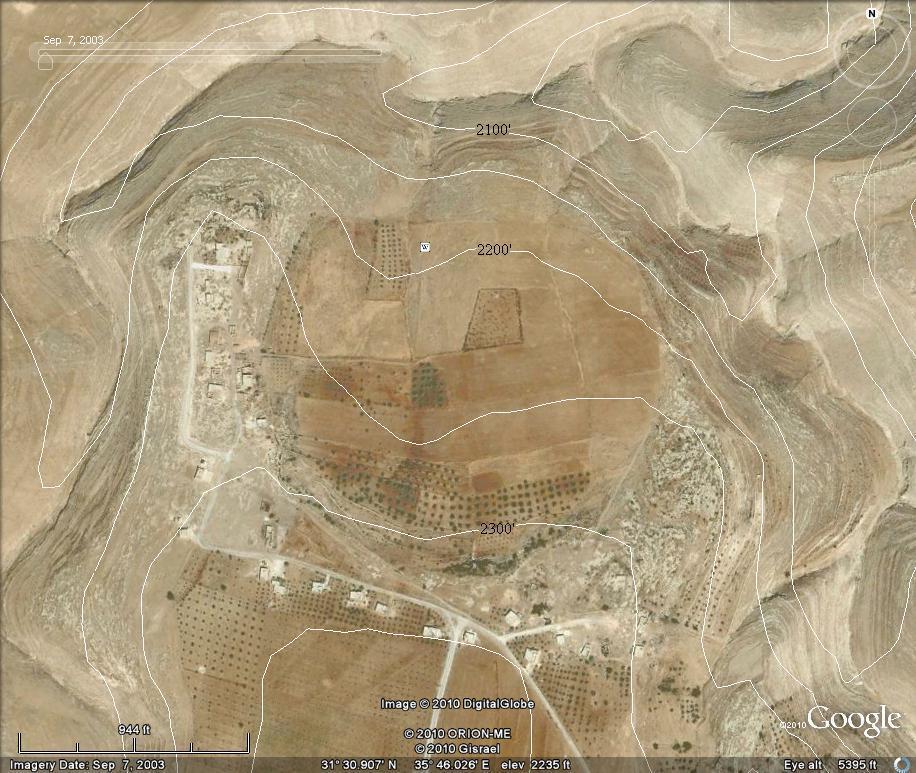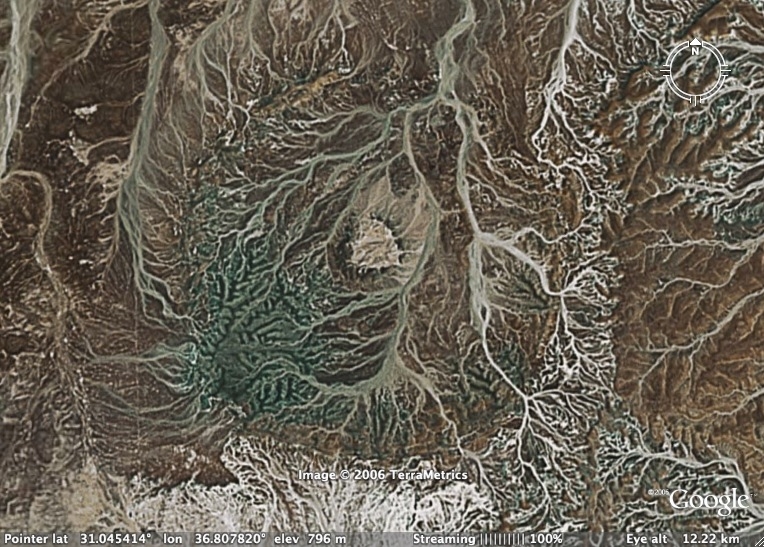|
The Place of the Biblical Apocalypse is Found |
|
Scientists Discover Region's
Largest Meteor Crater
Jordan Times - 08/08/2006  Possible Meteorite Impact Crater at Adh Dhuhaybah, Amman Governorate, Jordan SOURCE Jabel
Waqf as Suwwan crater From Wikipedia, the free
encyclopedia
The Jabal Waqf es Suwwan crater is an impact crater in Ma'an Governorate, Jordan, near the Saudi border.The crater has a diameter of 5.5 km. It is estimated at 37-56 million years old. It is exposed at the surface. The crater was proposed in 2006 by geologists Elias Salameh and Hani N. Khoury from the University of Jordan, along with German professor Werner Schneider. The bolide is estimated by Prof. Salameh to have been 100m in diameter, and to have had an impact velocity of 40–50 km/s. AMMAN -- A group of local and international scientists have discovered a huge crater in the eastern part of the country caused by a gigantic meteorite, thought to be the largest such find in the region. The impact site in Jabal Waqf es Swwan, some 200 kilometres east of the Karak Governorate close to the Saudi border, was discovered by University of Jordan geology professors Elias Salameh and Hani Khoury, along with German professor Werner Schneider. According to Salameh, the meteorite struck the area around 7,500-10,000 years ago with an impact diameter of about 100 metres. "The damage force of such an impact might equal 5,000 times that of the Hiroshima atomic bomb," according to Salameh, adding that it would have destroyed everything within a radius of hundreds of kilometres. The crater consists of two concentric circles. The diameter of the outer ring measures around 5.5km, with the inner ring measuring 2.7km. The impact size and velocity, according to Salameh, would have raised the atmospheric temperature within a radius of 10 kilometres to more than one thousand degrees centigrade, spewing millions of tonnes of rocks, vapour, dust and smoke into the atmosphere. This in turn would have formed an atmospheric cloud so large as to plunge the entire earth into darkness, with continuous rain for months or even years, resulting in the widespread flooding of low lands, according to a statement by the University of Jordan. The discovery is thought to be the largest such meteorite crater in the region. Future research at the site, which has been well-preserved due to the area's dry climate, will be supported by the University of Jordan and the Higher Council for Science and Technology. Highlighting the importance of the find, Salameh said the site is expected to explain many geologic and historic features and events such as calcinated rocks, molten rock, highly jointed and cracked rocks. There are around 130 crater structures of impact origin in the world. One of the oldest and largest clearly visible sites is the Vredefort Dome, located in South Africa. The original crater, now eroded, was probably 250 to 300 kilometres in diameter, larger than the Sudbury impact structure in Canada, about 200km in diameter. At two billion years old, Vredefort is far older than the Chixculub structure in Mexico which, with an age of 65 million years, is the site of the impact that is said to have led to the extinction of the dinosaurs. All relevant institutions in Jordan have been informed about the discovery, including the Badia Project, the Department of Lands and Survey and the Natural Resources Authority, in order to take the necessary steps to conserve the site.
|
 Proposed
East Jordan Impact Crater by Cintos 8/9/06
The attached KMZ file denotes the location of the site as determined by me using the location of Jabal Waqf es Swwan listed at the Satellite Views web site (www.satelliteviews.net). Using Google Earth, the circular structure is plainly visible, along with a raised central area approximately 1km in diameter. The KMZ file contains a circular overlay, which suggests an asymmetry of both the central area and the 5.5 km outer rim, which may be the manifestation of a shallow angle of impact. The SW sides of both the central rise and the outer ring are seem to be at a higher elevation, with the highest points being along azimuth N45º - SOURCE |
| The
Place of the Biblical Apocalypse is Found
14.08.2006 A giant meteor crater was discovered in the Jordanian desert, suggesting some terrible disaster that took place in this area back in the Stone Age. According to the scientists it was precisely this cataclysm that gave rise to the Sumerian end of the world legends and to the Biblical version of Apocalypse. “The gods of Anunnaki raised up their torches casting bright lights towards the Earth… The heavens were filled with despair and the daylight was overwhelmed by the covering darkness… The Earth was shattered like a jar of clay,” – it would be hard to find a more impressive description of the end times than the one produced in “The Epic of Gilgamesh.” Now the researchers in the Jordanian desert have found the traces of the great cataclysm which served as the historical foundation for the famous legend that dates back more than four thousand years. This epochal myth, in turn, finds many parallels in the gloomy Biblical plot describing the last days. In any case, now we have a giant crater formed no less than 10,000 years ago by an equally giant meteorite near the present Saudi Arabian border. Actually the crater was noticed and even put into some geological maps back in the 60’s, but for some reason it was then mistaken for an inactive volcano. This tragic mistake was brought to everyone’s attention by a German geologist Werner Schneider of Technical University of Braunschweig, reports Spiegel Online. Field research has verified Schneider’s suspicions: the crater was formed by a fallen meteorite that had a diameter of approximately a hundred meters. In particular Schneider and his colleagues from the Jordanian University discovered quartz minerals that had been disturbed by a wave force a long time ago. The changes in the nature of the quartz grid’s structure caused by this incident confirmed the “Meteorite Theory.” Besides the quartz grid, the local relief itself points to its being hit: concentric circles surround a hill that was raised up after the meteorite had landed in the center. The traveling speed of the large guest from outer space is estimated to have been around 160,000 kilometers per hour and the power of the explosion at the time of the impact exceeded by a thousand times that of the Hiroshima bomb. Millions of tons of dust and smoke were thrown a few kilometers upwards, and for hundreds of kilometers around the epicenter the entire area was instantly and entirely burned out. Supposing that the ancient people were observing the unfolding catastrophe (the explosion was visible thousands of kilometers away), it would doubtless leave a lasting impression on their curious minds and would most certainly inspire all kinds of creative outbursts. Plus this region is considered the “Cradle of Humanity.” If the date of the disaster is correctly estimated it would apparently be the “freshest” meteor crater in the Middle East . “This event without a doubt found reflection in many myths and tales of the peoples of the Ancient World. And of course they used a slightly different terminology that the one used by the present day NASA specialists,” comments Schneider. He adds that the picture presented to the eyes of the ancient cataclysm’s observers strongly reminds him of the passages from the “Apocalypse.” Source: Pravda.ru Translated by Natalia Vysotskaya |
| Huge
Meteorite Crater Discovered in Eastern Jordan
UPDATED:
17:01, August 08, 2006 A huge crater caused by a gigantic meteorite has been discovered recently in the eastern part of Jordan, the largest meteorite crater in the region, the Jordan Times reported on Tuesday. The impact site in Jabal Waqf es Swwan, some 200 km east of the Karak governorate in eastern Jordan, was discovered by geology professors of University of Jordan Elias Salameh and Hani Khoury, along with German professor Werner Schneider. A meteorite struck the area around 7,500-10,000 years ago with an impact diameter of about 100 meters, the report said. "The damage force of such an impact might equal 5,000 times that of the Hiroshima atomic bomb," Salameh said, adding that it would have destroyed everything within a radius of hundreds of kilometers. The crater consists of two concentric circles. The diameter of the outer ring measures around 5.5 km, with the inner ring measuring 2.7 km. The impact size and velocity, according to Salameh, would have raised the atmospheric temperature within a radius of 10 kilometers to more than 1,000 degrees centigrade, spewing millions of tons of rocks, vapor, dust and smoke into the atmosphere. The discovery is thought to be the largest such meteorite crater in the region, a statement issued by the University of Jordan said. Salameh said that the site is expected to explain many geologic and historic features and events such as calcinated rocks, molten rock, highly jointed and cracked rocks. There are around 130 crater structures of impact origin in the world. One of the oldest and largest clearly visible sites is the Vredefort Dome, probably 250 to 300 kilometers in diameter, located in South Africa. |
Related
Links:
Papers:
|
| FAIR USE NOTICE: This page contains copyrighted material the use of which has not been specifically authorized by the copyright owner. Pegasus Research Consortium distributes this material without profit to those who have expressed a prior interest in receiving the included information for research and educational purposes. We believe this constitutes a fair use of any such copyrighted material as provided for in 17 U.S.C § 107. If you wish to use copyrighted material from this site for purposes of your own that go beyond fair use, you must obtain permission from the copyright owner. |
| ~ MENU ~ |
